August 28, 2025
ISLAMABAD – From a valley of snow, greenery, and bustling bazaars to a city drowning in garbage, sewage, and dust — Quetta’s decline is a prime example of urban neglect.
In Quetta’s Kali Ismail area, near the Balochistan Board office on Samungli Road, 12-year-old Salman, a seminary student, rummaged through a garbage dumping site to pick up a baseball. He needed it for his next fastball to Akram, who stood poised to bat — right in the middle of the trash. “We’re used to playing here,” Salman shrugged. “We wash our hands with regular water.” Like many children in the area, he had no idea how hazardous the dumping ground could be to his health.
“It’s been five months, and there’s been no action from the authorities,“ lamented Jameel Langove, who runs a flour mill nearby. “The dumping ground has become a haven for drug addicts and immoral activities. It’s affecting our neighbourhood and our children.” He recounted how a recent storm had blown heaps of garbage into nearby homes. Living so close to the site, residents, particularly the elderly, now struggle with asthma and other breathing problems caused by dust and waste polluting the air.
Quetta, once fondly referred to as “Little London”, is buckling under a range of urban pressures: irregular development, an inadequate sewerage system, traffic congestion in the city centre, overflowing manholes, a shortage of clean drinking water, unmanaged dumping sites, unregulated crush plants, sewage water used for cultivation, a lack of green spaces and playgrounds, and narrow, clogged inner roads.
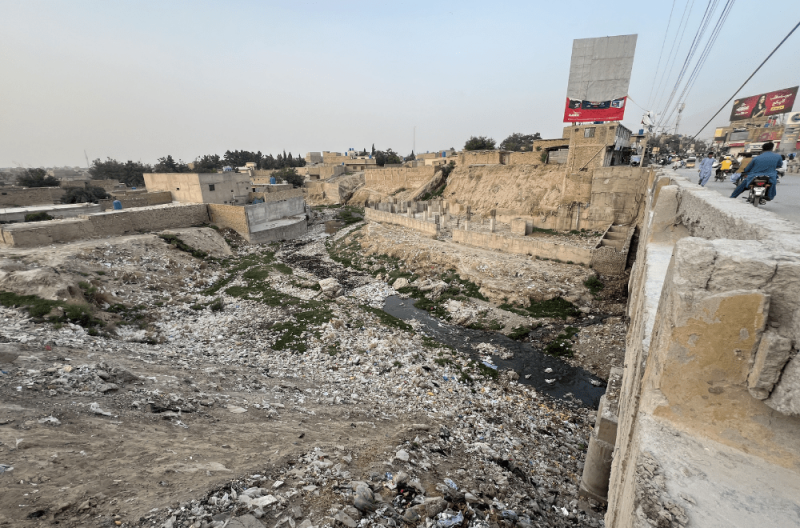
The Brewery Road bridge spans the city nullah. PHOTO: DAWN
“Rapid expansion beyond the city’s original design — initially planned for around 100,000 residents — has resulted in a population exceeding 1 million. However, many of the master planning guidelines remain unimplemented,” lamented Sanaullah Panezai, an Associate Professor at the Department of Geography and Regional Planning at Balochistan University.
At the same time, Quetta faces acute vulnerability to natural and man-made hazards: floods, earthquakes, landslides, and urban disasters amplify planning failures. Panezai added that in 2022, floods caused significant damage to the city’s physical and water infrastructure.
To top it off, the city generates around 1,600 tonnes of garbage every day, yet only 400 tonnes are collected due to a severe funding shortfall. The city receives Rs1 billion for waste management — far below the Rs4 billion required.
Amid all this, Quetta’s bazaars, once bustling with colour and life, now lie under a pall of dust and decay. Areas such as Liaqat Bazaar, Prince Road, Gowrgath Singh Road, Sirki Road, Masjid Road, Jinnah Road, Kawari Road, Hazara Town, Marri Abad, Nawa Kili, Pashtoon Abad, and Sariab, along with the Western and Eastern Bypass roads, bear the marks of neglect.
If you ask the authorities, though, they will tell you all is well, coupled with promises laced in bureaucratic jargon of big projects and development.
Rafiq Baloch, Quetta development project director, told Dawn.com that 15 projects had been launched in recent years, 10 of which are now complete. These include the construction of 97 kilometres of internal streets in the Sariab area. Five more projects are currently in progress, he said, with roads being built alongside sewage systems to ensure proper water drainage. He also noted that six sports complexes have been completed across the city.

The city’s nullah runs outside the Balochistan environment department. PHOTO: DAWN
Inside the city’s failing sewage system
And yet, none of this explains the state of the city. In recent years, for instance, the open sewage system at the intersection of Jan Muhammad Road and Kawari Road, right next to Quetta’s Children’s Hospital, has become a major public health and urban management concern, affecting residents, local businesses, commuters, and, most critically, the hospital’s young patients.
Jaffar Khan, a resident who lives nearby, frequently visits the hospital with his wife after the recent birth of their baby. The newborn has been suffering from diarrhoea. “We avoid taking a rickshaw to the hospital because the open sewage causes traffic jams,” Jaffar explained. “Instead, we walk — since it’s close by — but we worry that the filthy water, which has been stagnant here for months, could expose our child to new diseases.”
On Kawari Road, shopkeeper Asmat Ullah points to a gaping five-foot-wide sewage drain outside his furniture store. Many women, motorcyclists, and rickshaw drivers, he says, have fallen into it. “It’s also hurting our business,” he added, “because customers avoid coming here due to the stench and the mosquitoes breeding in the sewage.” Instead of easing sanitation issues, the three sewage lines running along the road have become a persistent public nuisance.
Quetta’s main Civil Hospital lies just a short walk from the Red Zone and the Commissioner’s Office, yet the footpaths around it, particularly on three corners, are dotted with open drains, potholes, and encroaching vendor stalls, making them dangerous and unusable for pedestrians. Similarly, a deep, uncovered sewage channel in front of Balochistan University reflects the city’s crumbling urban infrastructure, even within its key institutions.
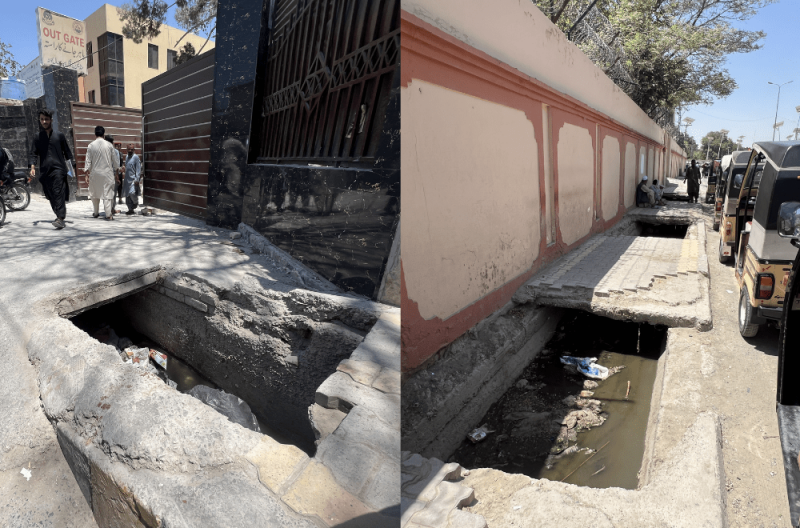
Open sewerage channel in front of Civil Hospital. PHOTOS: DAWN
“Sewage infrastructure in Quetta is in a deplorable condition, primarily due to poor design,” acknowledged Dr Faisal Ahmed Khan, Chief Executive Officer of Balochistan’s public-private partnership authority. The authority also oversees the Safa Quetta project, responsible for maintaining the city’s cleanliness and managing its waste.
He identified weak sewage infrastructure — compounded by the widespread use of plastic bags — as the main cause of blocked drains across the city. Despite these shortcomings, Dr Khan noted that the waste management contractor has performed relatively well in drain desilting and sewage maintenance, citing the limited number of drain overflows during Quetta’s recent two rain spells.
“The services may not be impeccable, but given the challenging ground realities and civic behaviour, the sewage system has been maintained reasonably well,” he said. “In the downtown area, about 128 dump points have been eliminated.”
Dr Khan interestingly also pointed out that several dumping sites, near Killi Ismail, Jinnah Town, Shehbaz Town, and certain stretches of Zarghoon Road and Jinnah Road, do not fall under Quetta’s municipal jurisdiction but within the control of the cantonment board.
Solid waste disposal in the river
City nullah, originating in the cantonment area, winds through several key parts of Quetta including Sumangali Road, Kharotabad, Brewery Road near Bolan Medical Complex, and along Kirani Road before merging with Sariab Road. Instead of fulfilling its natural role, the waterway has become a major dumping ground for both solid and liquid waste.
Along Sumangali Road, the nullah flows past critical institutions, including the Cenar Cancer Hospital Quetta (the only cancer hospital in Balochistan), multiple schools, mosques, residential areas, an old age home, markets, and even the office of the environment department. Yet, it no longer resembles a river; its banks now function as an open landfill.
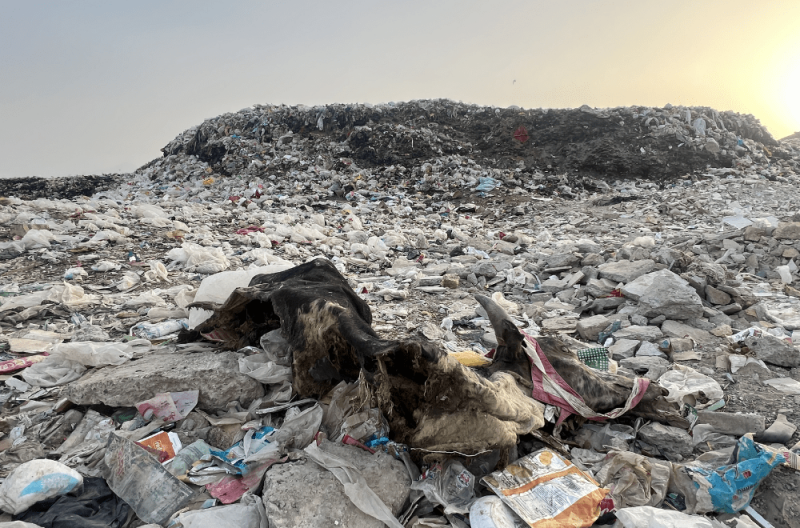
Animal waste in front of Bolan Medical College along the city nullah. PHOTO: DAWN
“This might be called a posh area, but look around — the conditions are horrible,” lamented Asif Ali, a long-time resident of Lehri Gate. “Women, children, the elderly, students, even patients heading to nearby hospitals are at risk. The filth, the smell — this isn’t what you expect in a neighbourhood like this.”
On the brink of a water crisis
Even as sewage lines and gutters overflow in the provincial capital, the water table has fallen at an alarming rate — from 300 feet in 2010 to 600 feet by 2021 — an average annual drop of 30 feet. Since no official groundwater survey has been conducted since 2021, current data remains unavailable, fuelling concerns that depletion may be continuing or even accelerating.
Over the years, the city’s drinking water shortage has become increasingly acute. “The water supply services are neither adequate nor safe for drinking and do not meet our basic needs. That’s why we have to arrange water tankers ourselves,” said Danish Mengal, a resident of Huda Road.
“The city’s demand is 61 million gallons per day, while it can barely supply 35 million gallons per day,” noted Panezai. “Over 500 tube wells are extracting water, primarily for drinking purposes. Due to over-extraction and disrupted natural recharge, groundwater levels have dropped below 360 metres.”
Large parts of the city, including Kirani Road, sections of Qambrani Road, Bashir Chowk, and Satellite Town, face severe shortages. Nimat Mazhar, a resident and council member affiliated with the Balochistan National Party-M said, “We have around 15 to 20 private tube wells in the area. Initially, private connections from these wells cost between Rs40,000 and Rs50,000. But after intervention from the local administration and community, the cost has dropped to around Rs2,000 per connection.”
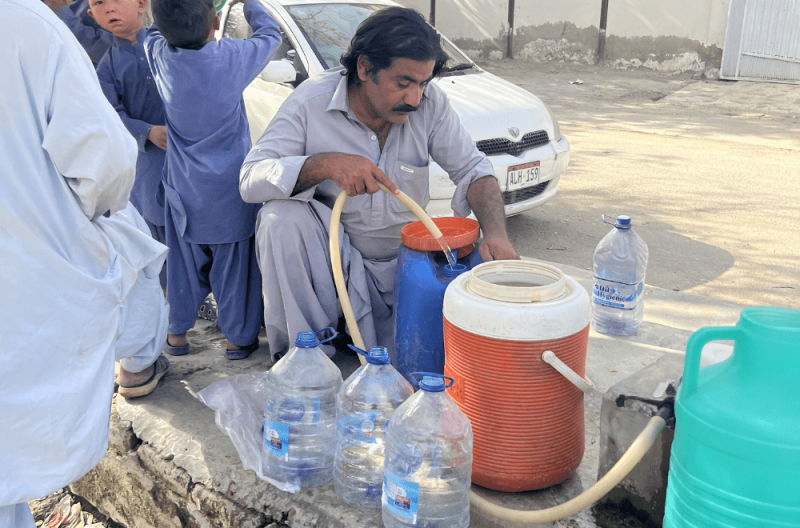
In Jinnah Town, limited access to clean water compels residents to depend on unsafe sources. PHOTO: DAWN
Mazhar added that in Hazara Town, water supply and pricing remain entirely unregulated and at the mercy of so-called water mafias. “In summer, they create more problems by cutting off supply, claiming electricity disconnection due to unpaid bills. This forces people to buy water from tankers, which can cost anywhere from Rs4,000 to Rs8,000, depending entirely on what they decide.”
The government had initially planned to supply water to the provincial capital via the Kachhi Canal, but later shifted focus to building dams for long-term sustainability. Under this initiative, work began on the Mangi Dam in 2017. In the 2023–24 financial year, Rs861 million were spent on the project, with an additional Rs1,000 million allocated for 2025–26.
Budget documents show that despite mounting concerns over water resources, the provincial government also allocated millions to new tube well projects in Quetta. Meanwhile, during a Public Accounts Committee (PAC) meeting last year, chaired by Asghar Khan Tareen, serious concerns were raised over delays and escalating costs at the Mangi Dam. The meeting revealed that, despite Rs18 billion having been spent already, the dam remains incomplete.
A bumpy road ahead
At the southern entrance to Quetta, where the Greenbelt of Balochistan connects Karachi and Sindh to the city via Gahi Khan Chowk, a bridge has stood incomplete for several months. This stalled construction is not only generating dust and pollution for nearby shopkeepers but also causing severe traffic disruptions at one of the city’s most critical junctions.
Gul Mir Khan, who runs a pakora shop near the unfinished bridge, voiced his frustration. “We’re losing customers because of this,” he said. “The dust is causing breathing problems, and when it rains, the whole area turns into a river.”

Waste disposal site in front of BMC. PHOTO: DAWN
According to Khan, several neighbouring shops have already closed due to the harsh conditions. Riaz Lehri, a local transporter operating nearby, echoed the frustration: “Every day, we get stuck here for nearly two hours,” he said, adding that the bridge has been incomplete for two years and that current construction activity feels more symbolic than substantive.
“Quetta lacks a mass transit system; roads are narrow and congested. Traffic worsens due to poor planning. The Green Bus Service is a good initiative; however, it does not meet the city’s needs for daily commuting and mass transport,” noted associate professor Panezai, responding to a question about Quetta’s roads and public transportation.
Elsewhere, road infrastructure remains in poor shape. Karani Road, the main approach to Hazara Town, is plagued with potholes, according to resident Nimat Mazhar. On Samungli Road, already impacted by the nearby city nullah drainage, road extension work has been delayed. For his part, Quetta Development Project Director Rafiq Baloch said the project is now expected to be completed within the next two months.
Has the city lost its glory?
Quetta, a valley where snow once fell, cool winds swept through, and majestic peaks — Chiltan, Takatu, Zarghoon, and Koh-i-Murdar — stood guard, has now transformed into a city of concrete. The thriving greenery that once fringed its outskirts has been steadily erased by urban development. Government neglect, poor civic planning, and limited public awareness have left the city short of green spaces, cinemas and theatres, public toilets, and freshwater canals.
“Sariab Road was once lined with trees and lush green plants on both sides. Sometimes, we travelled on the rooftop of the college bus just to feel the freshness of the air,” recalled Naseem Javeed, a resident of Marriabad Road, reminiscing his student life. “We often visited our Baloch friends in Kachi Bagh to enjoy fresh fruits and lassi,” he added, remembering the city’s inclusivity and charm. Once, the trees near the Red Zone echoed with the songs of hoopoes, mynas, nightingales, quails, and sparrows. Now, Javeed said, the air is thick with the noise and pollution of traffic.
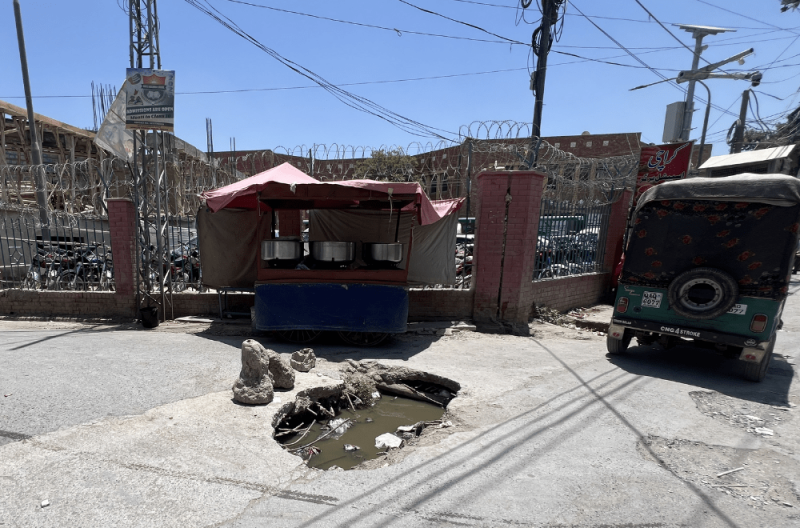
Open drainage outside the children’s hospital poses health risks and causes traffic disruptions. PHOTO: DAWN
In Marriabad, the same city nullah appears clean and well-maintained, thanks to the Hazara community’s habit of avoiding waste dumping and taking responsibility for its upkeep. This sense of civic responsibility contrasts sharply with other parts of Quetta, where garbage piles up amid official negligence and public apathy.
“The nullah used to be well maintained; its brick lining was clean, and sewage water flowed smoothly without obstruction,” said Captain Mubarak Ali Hazara. “Sadly, the city has lost much of its colonial-era architecture, which once contributed to its charm.” He lamented that although the city’s administration and political leadership are now local and not colonial, they still fail to take ownership.
When asked about civic behaviour in Quetta, Dr Faisal Ahmed Khan said it is “as poor as elsewhere in Pakistan.” Despite hundreds of waste bins placed across the city, litter often collects around them, and bin wheels are stolen within a week. Sanitation workers have even been attacked, and attempts to collect household service fees are often rejected.
In the face of these challenges, the city crumbles under the weight of its own waste, buried deeper by apathy both on the part of its administrators as well as its citizens.
The writer is a journalist and researcher with a particular interest in political development and security in Pakistan’s Balochistan and Iran’s Sistan-va-Baluchestan provinces. He tweets at @ImtiazBaluch.


